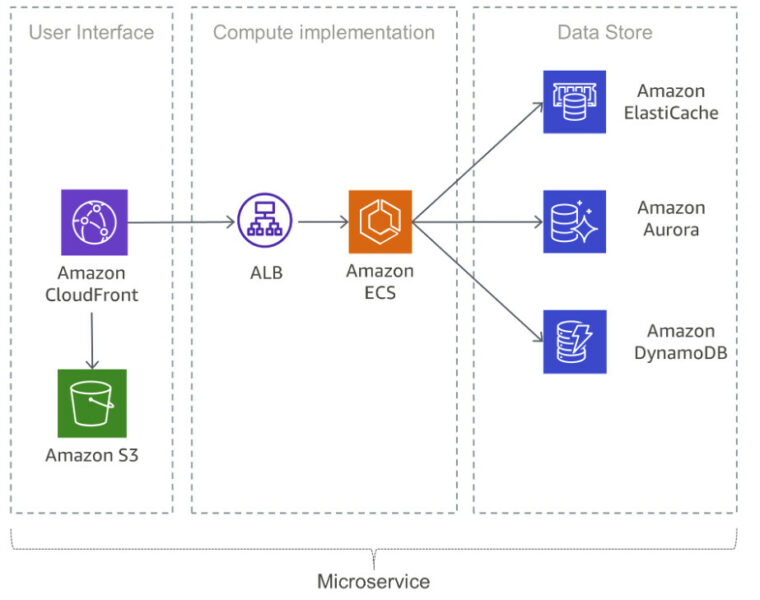
Microservices is an architectural paradigm in which an application comprises tiny, loosely connected, and independently deployable services. Each microservice is in charge of a given function or domain, and they communicate with one another via APIs. This architectural pattern enhances flexibility, scalability, and maintainability because changes can be made to a single microservice without affecting the entire application. AWS is a prominent cloud platform that offers various services to developers to help them build, deploy, and run applications. Also, AWS gives various tools and services to help developers build, implement, and manage microservices-based applications. AWS is an ideal environment for deploying and growing microservices applications due to its worldwide infrastructure, high availability, and pay-as-you-go pricing mechanism. Building microservices in AWS has various benefits, including.
- Scalability – Microservices may be scaled separately, allowing you to provide resources to particular services based on their needs. You can efficiently scale your microservices with the help of AWS services like Elastic Container Service (ECS) and Lambda.
- Flexibility – You may use multiple programming languages, frameworks, and databases for each service using microservices. This enables you to select the most appropriate technology stack for each microservice, improving performance and resource consumption.
- Resiliency – You may improve your application’s resilience by breaking it into separate, independent services. If one microservice fails, the entire application sometimes fails. AWS provides monitoring and recovery tools to ensure your application stays highly available.
- Faster Deployment – Because each microservice is self-contained, you can deploy updates and new features without affecting the entire application. This allows for more frequent and faster releases, shortening your development cycle.
Why Do Organizations Use Microservices Pattern In AWS?
Building Cloud-Native Applications
Microservices are essential for designing cloud-native applications on AWS. Cloud-native applications are built to fully use the cloud environment fully, leveraging its scalability, flexibility, and distributed nature. By breaking your application into smaller, self-contained services, you may build a highly scalable and robust system that can react to changing business requirements and consumer demands.
Enhancing DevOps Practices
Microservices can also assist in improving AWS DevOps practices. DevOps is a culture that encourages development and operations teams to collaborate to provide high-quality software quickly and reliably. Thanks to microservices, development teams may work on many services concurrently, minimizing the likelihood of disputes and bottlenecks. Furthermore, deploying and managing microservices on AWS with infrastructure-as-code (IAC) tools like AWS CloudFormation may assist in automating infrastructure provisioning and management, improving your DevOps processes even further.
Supporting Digital Transformation
Many organizations are undergoing digital transformation to remain competitive in today’s fast-paced business world. Adopting microservices on AWS will assist in accelerating this change by enabling you to build flexible, scalable, and resilient applications that can swiftly react to new business opportunities and problems.
AWS Services For Microservices
AWS offers numerous cloud services that are ideal for a microservices architecture. These services may be used to set up microservices applications in the cloud easily.
Amazon Elastic Container Service (ECS)
ECS is an AWS-managed container orchestration service that lets you deploy, manage, and scale Docker containers. It is seen as a less complex alternative to Kubernetes. It integrates deeply with other AWS services, including Elastic Load Balancing, Amazon RDS, and AWS Identity and Access Management (IAM). ECS is a fantastic solution for deploying microservices on AWS because it allows you to scale and manage the lifecycle of your services quickly.
AWS Lambda
AWS Lambda is a serverless computing service that lets you run code without provisioning or managing servers. With Lambda, you can build serverless microservices that scale based on the number of requests without worrying about the underlying infrastructure. Lambda supports various programming languages, including Python, Node.js, and Java, allowing you to build microservices in the language of your choice.
Amazon API Gateway
API Gateway is a completely managed service that makes creating, publishing, and managing APIs for your microservices simple. It contains features like caching, logging, security, and microservices, enabling you to build strong and scalable APIs for your microservices. You can also use API Gateway to produce client SDKs and custom domain names to simplify the integration of your microservices with other applications.
AWS Step Functions
Step Functions is a serverless workflow service that assists you in coordinating microservices and building complicated applications. It enables the creation and execution of state machines that orchestrate several AWS Lambda functions and other AWS services. Step Functions simplify the coordination and error handling of your microservices, improving their dependability and maintainability.
Amazon Reference Architecture For Microservices
A reference architecture for an AWS-based microservices application is depicted in the figure below. Let’s go through the main components of this design (the talk is based on Amazon documentation).
User Interface
JavaScript frameworks are commonly used in modern web applications to develop single-page applications that communicate over REST or RESTful API. Static web content may be managed using Amazon’s Simple Storage Service (Amazon S3) and Amazon CloudFront. Latency is significantly decreased since microservice clients get service from the nearest edge location and retrieve responses from a cache or a proxy server with optimized connections to the source.
Microservices
AWS offers various integrated components that help deploy microservices as serverless operations or containers.
- AWS Lambda allows you to submit your code. Lambda will manage everything needed to run and scale your implementation to match your real demand curve—all without the requirement for infrastructure management. Lambda supports various programming languages and may be called directly from any web, mobile app, or AWS service.
- AWS Fargate is a serverless computing engine for containers that works with both Amazon ECS and Amazon EKS. It handles the supply of sufficient computing resources for running your container applications.
- Through container placement methods and limits, Amazon ECS allows you to tailor how it puts and finishes jobs. A task placement restriction is a rule that is considered during task placement. You may give your container instances attributes and then use a constraint to position tasks depending on these qualities.
- Amazon EKS manages and updates Kubernetes while allowing you to use current plugins and tooling from the Kubernetes community. Applications running on Amazon EKS are completely interoperable with those running in any standard Kubernetes environment, including on-premises data centers and public clouds.
- Amazon ECR is a managed container registry that allows you to store Docker images used in Amazon ECS or Amazon EKS. Amazon ECR eliminates the requirement for you to manage and scale the infrastructure required for your container registry.
Data Store
A data store is used to keep microservice data safe. In-memory caches like Memcached or Redis are commonly used for session data storage. Both solutions are available from Amazon as part of the managed Amazon ElastiCache service. AWS provides six database engines as managed services via Amazon Relational Database Service (Amazon RDS) if the microservices application requires relational databases. NoSQL databases, which emphasize scalability, performance, and availability, are another option. Amazon DynamoDB enables you to construct database tables capable of storing any data and handling any level of traffic.
Implementing Microservices On AWS – Best Practices
Leverage Amazon Automation Capabilities
Using tools like AWS CloudFormation, you can automate infrastructure provisioning, deployment, and management. By automating these activities, you may decrease human mistakes, improve consistency, and accelerate development and deployment cycles.
Implement Robust Monitoring And Logging
Monitoring and logging are critical for ensuring your microservices’ health and performance. To gather metrics, traces, and logs, use AWS services like Amazon CloudWatch, AWS X-Ray, and AWS CloudTrail. This data may help you detect and fix issues, manage resource use, and improve the overall performance of your microservices.
Secure Your Microservices
When creating microservices on AWS, security should be a key focus. Control access to your microservices and AWS resources using AWS Identity and Access Management (IAM). To protect your data, use encryption both in transit and at rest. Finally, employ tools like AWS WAF and AWS Shield to protect your microservices from security risks.
Plan For Failure
Plan for failure while designing your microservices for resiliency. Use solutions like circuit breakers, retries, and fallbacks to manage failures gracefully. Use AWS services like Auto Scaling and Amazon Route 53 to assure your microservices’ high availability and fault tolerance. You can master microservices and build scalable, high-performance applications by following these best practices and leveraging AWS’s strong tools and services. Begin your adventure today and take your application development to the next level.
Make An Informed Choice Between Serverless, Containers, And Full Kubernetes
Consider the following while selecting a runtime platform.
- AWS Lambda is best suited for lightweight microservices with variable demand or short, stateless activities, allowing developers to concentrate on their code rather than the underlying infrastructure.
- Amazon ECS is suitable for long-running applications and microservices that require orchestration but do not require the full capability of Kubernetes.
Amazon EKS is suitable for organizations that have embraced Kubernetes as their orchestration standard, providing greater flexibility and control but necessitating more management resources and knowledge.



